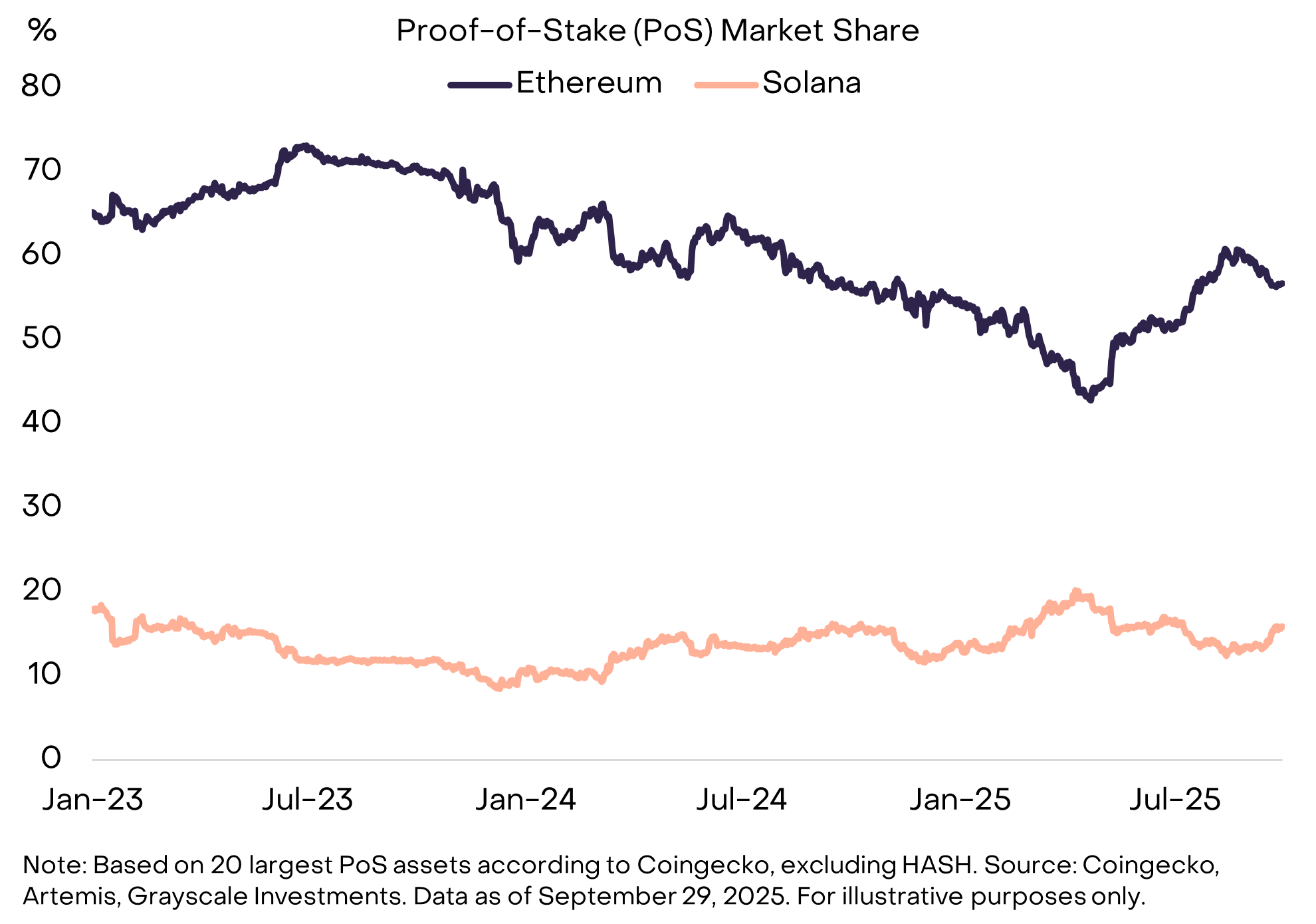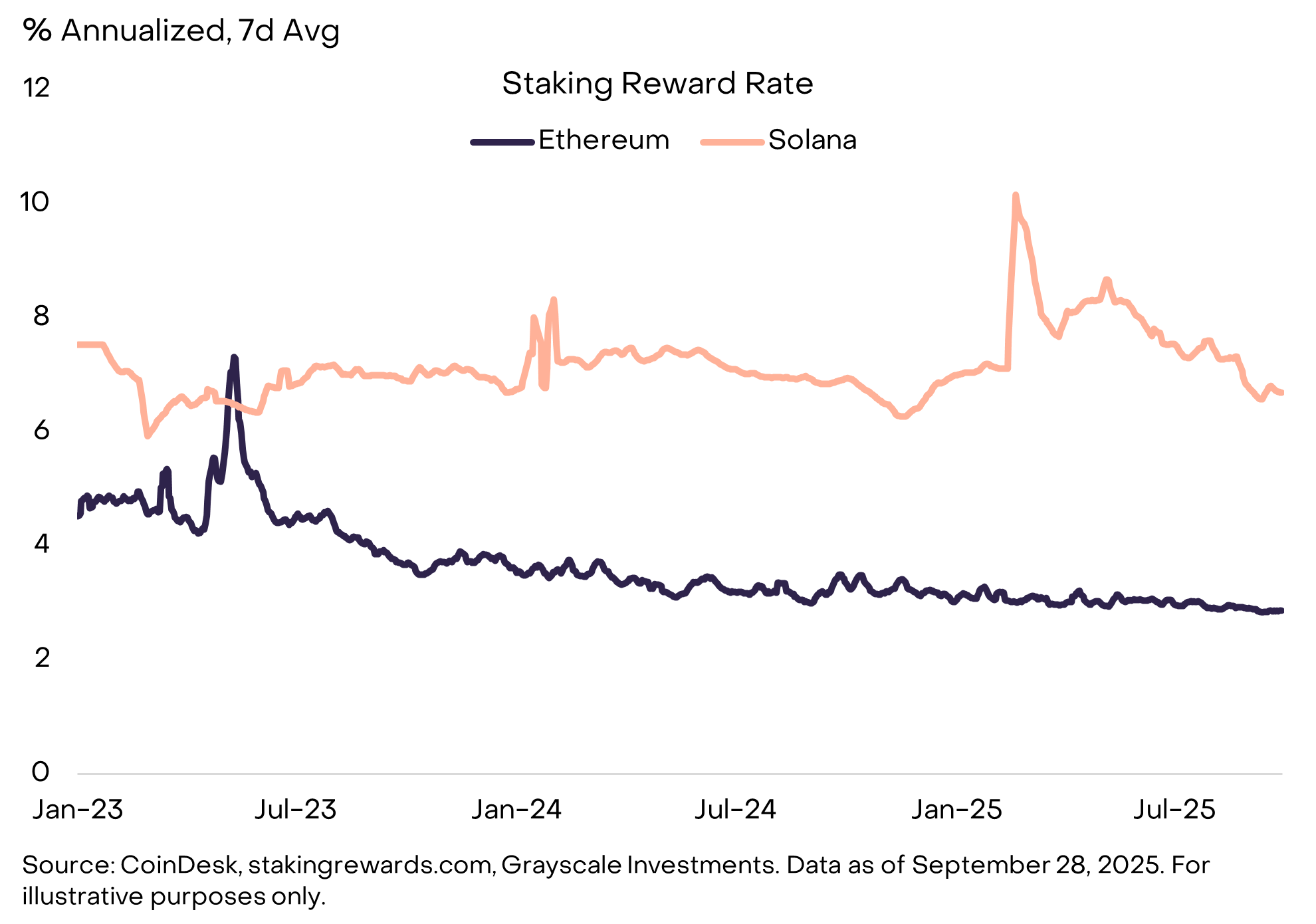Last Updated: 10/2/2025 | 12 min. read
Proof-of-Work secures blockchains with electricity and specialized hardware. Miners compete to add blocks and earn rewards through issuance and fees. Bitcoin represents the overwhelming share of PoW assets—some 97%—and about 63% of total crypto market capitalization.[2]
Proof-of-Stake helps secure blockchains by requiring validators to post or “lock” tokens as collateral. Validators propose and validate blocks and can be rewarded with issuance and fees. In other words, staking is central to the network’s economics and security.
Stakers who perform their duties correctly are rewarded with additional tokens, while those who act against the interest of the chain can see their stake “slashed”—that is, penalized and reduced.[3]
Ethereum switched from PoW to PoS in 2022, and the result was a reduction in energy use of over 99% (for more background see From Miners to Stakers: How Staking Secures the Ethereum Blockchain). Ethereum and Solana are the largest blockchains utilizing PoS today, accounting for roughly 57% and 16% of overall PoS market value, respectively (Exhibit 1). Other notable PoS networks with meaningful market share include Cardano (3%), Hyperliquid (1%), Avalanche (1%), and Sui (1%).[4]
Exhibit 1: Ethereum is largest proof-of-stake blockchain by market capitalization

Staking is more than a way to earn rewards—it is the foundation of security and economic design in modern blockchains. When participants stake, they commit capital that protects the network, while earning variable returns linked to network activity.
In the broader digital asset economy, staking functions as infrastructure:
As digital assets mature, staking will stand alongside payment rails and clearing systems as one of the essential pillars of financial infrastructure. Institutional interest in crypto investments may rise alongside the increased prevalence of staking. Institutions value income, and the ability to add staking rewards to the potential return on crypto investments should boost liquidity and on-chain participation.
Native blockchain tokens serve three essential purposes:
The staking ecosystem is made up of a variety of players, which fall into three main groups:
There are several ways to participate in staking, varying in technical difficulty and risk:
Staking offers investors the ability to earn income on crypto assets intended to be held for the long-term. That being said, rewards are not fixed like interest payments on a bond (Exhibit 2). They vary over time, shaped by a number of factors, including the network’s economic design (token issuance schedules, transaction fees, slashing), the size of the validator set, and market activity (transaction demand and maximum extractable value opportunities).[6]
Exhibit 2: Staking reward rates vary across tokens and over time

Ethereum
Solana
Staking is not just income—it is a critical part of the digital asset economy. It aligns incentives among participants and secures blockchains. It also provides predictable returns for investors, protocols, and service providers by offering a structurally distinct source of income for digital asset portfolios. Staking is infrastructure for the digital asset system and is the backbone of the economic model on the blockchain.
Index definitions: FTSE/Grayscale Crypto Sectors total market index. CoinDesk Composite Ether Staking Rate (CESR) is a daily benchmark rate that represents the mean, annualized staking yield of the Ethereum validator population.
[1] In the 180 days ending September 28, 2025, the Ethereum staking reward rate averaged 2.98% based on the CoinDesk Composite Ether Staking Rate (CESR).
[2] Source: Artemis, Coingecko, FTSE/Russell, Grayscale Investments. Share of PoW assets based on top 20 PoW networks by market cap according to Coingecko. Share of total crypto market capitalization based on FTSE/Grayscale Crypto Sectors total market index. Data as of September 30, 2025. For illustrative purposes only.
[3] Rewards are not guaranteed in every instance — they are expected outcomes for validators who perform duties correctly. Each proof-of-stake network defines its own reward schedule and inflation mechanics, but actual payouts depend on factors like validator uptime, proper performance, and the total amount staked on the network. For example, if a validator goes offline or fails to submit blocks, they may receive reduced rewards or none at all. So while the protocol is designed to reward good behavior with additional tokens, the guarantee is conditional on validators fulfilling their responsibilities consistently.
[4] Source: Artemis, Coingecko, Grayscale Investments. Based on 20 largest PoS assets according to Coingecko, excluding HASH. Data as of September 29, 2025. For illustrative purposes only.
[5] Ethereum does not natively support delegation; instead, holders participate through staking pools or liquid staking protocols.
[6] Maximum extractable value (MEV) refers to additional rewards that may be available from optimal block construction; MEV rewards are distinct from staking rewards.
Important Disclosures
Investments in digital assets are speculative investments that involve high degrees of risk, including a partial or total loss of invested funds. Investments in digital assets are not suitable for any investor that cannot afford loss of the entire investment.
All content is original and has been researched and produced by Grayscale Investments Sponsors, LLC (“Grayscale”) unless otherwise stated herein. No part of this content may be reproduced in any form, or referred to in any other publication, without the express consent of Grayscale.
This information should not be relied upon as research, legal, tax or investment advice, or a recommendation regarding any products, strategies, or any investment in particular. This material is strictly for illustrative, educational, or informational purposes and is subject to change. This content does not constitute an offer to sell or the solicitation of an offer to sell or buy any security in any jurisdiction where such an offer or solicitation would be illegal. There is not enough information contained in this content to make an investment decision and any information contained herein should not be used as a basis for this purpose.
This content does not constitute a recommendation or take into account the particular investment objectives, financial situations, or needs of investors. Grayscale and its employees may hold certain of the digital assets mentioned herein.
The price and value of assets referred to in this content and the income from them may fluctuate. Past performance is not indicative of the future performance of any assets referred to herein. Fluctuations in exchange rates could have adverse effects on the value or price of, or income derived from, certain investments.
Certain of the statements contained herein may be statements of future expectations and other forward-looking statements that are based on Grayscale’s views and assumptions and involve known and unknown risks and uncertainties that could cause actual results, performance, or events to differ materially from those expressed or implied in such statements. In addition to statements that are forward-looking by reason of context, the words “may, will, should, could, can, expects, plans, intends, anticipates, believes, estimates, predicts, potential, projected, or continue” and similar expressions identify forward-looking statements. Grayscale assumes no obligation to update any forward-looking statements contained herein and you should not place undue reliance on such statements, which speak only as of the date hereof. Although Grayscale has taken reasonable care to ensure that the information contained herein is accurate, no representation or warranty (including liability towards third parties), expressed or implied, is made by Grayscale as to its accuracy, reliability, or completeness. You should not make any investment decisions based on these estimates and forward-looking statements.
There is no guarantee that the market conditions during the past period will be present in the future. Rather, it is most likely that the future market conditions will differ significantly from those of this past period, which could have a materially adverse impact on future returns. NO REPRESENTATION IS BEING MADE THAT ANY ACCOUNT WILL OR IS LIKELY TO ACHIEVE PROFITS OR LOSSES SIMILAR TO THOSE SHOWN. PAST PERFORMANCE IS NOT INDICATIVE OF FUTURE RESULTS. We selected the timeframe for our analysis because we believe it broadly constitutes the most complete historical dataset for the digital assets that we have chosen to analyze.
© 2025 Grayscale. All trademarks, service marks and/or trade names (e.g., G™, GRAYSCALE®, GRAYSCALE CRYPTO SECTORS™ and GRAYSCALE INVESTMENTS®) are owned and/or registered by Grayscale.